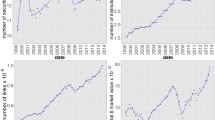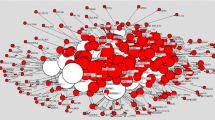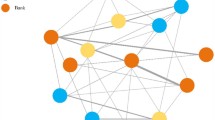Abstract
By exploiting a bipartite network representation of the relationships between mutual funds and portfolio holdings, we propose an indicator that we derive from the analysis of the network, labelled the Average Commonality Coefficient (ACC), which measures how frequently the assets in the fund portfolio are present in the portfolios of the other funds of the market. This indicator reflects the investment behavior of funds’ managers as a function of the popularity of the assets they held. We show that ACC provides useful information to discriminate between funds investing in niche markets and those investing in more popular assets. More importantly, we find that ACC is able to provide indication on the performance of the funds. In particular, we find that funds investing in less popular assets generally outperform those investing in more popular financial instruments, even when correcting for standard factors. Moreover, funds with a low ACC have been less affected by the 2007–2008 global financial crisis, likely because less exposed to fire sales spillovers.






Similar content being viewed by others
Notes
In the paper the terms constituents and assets, or holdings and compositions are considered interchangeable.
Following Cohen et al. (2005) we include the annual expense ratio and 12(b)1 fees given by CRSP; we divide these amounts by 252 to get daily quota, and we add the resulting value to each daily net fund’s return to obtain gross returns.
The interested reader may refer to the Financial Crisis Timeline, provided by the Federal Reserve Bank of St. Louis, for a detailed list of episodes related to the subprime crisis. See: https://www.stlouisfed.org/financial-crisis/full-timeline.
To be precise, the quantity \({\small k}_{F_{i},0}\) represents the number of constituents held by a fund whose holding is greater than or equal to the share held on average by the other funds.
We have also applied higher order measures of commonality as, for instance, \({\small k}_{F_{i},2}\) to compute investment strategies along the line described in the paper. Since results are in line with the ones presented in the paper, for sake of brevity, we exclude them from the work but they are available from authors upon request.
We use subscripts 3f and 5f to indicate alpha computed from the three- and the five-factors model, respectively. The estimate of portfolio expected return is computed as \(r_{3f} = R_{f}+\beta _{1}(R_{m}-R_{f})+\beta _{2} SMB + \beta _{3} HML + \alpha \), where the market premium (\(R_{m} - R_{f}\)) is enriched by factors that refer to Small minus Big capitalization (SMB) and High minus Low book-to-market ratio (HML); the five factors model adds to the previous three factors model the profitability (Robust minus Weak, RMW) and the investment (Conservative minus Aggressive, CMA) factors.
For the topological properties ACC and diversification the top best performer decile refers to Q1, while it is Q10 for past-\({\hat{\alpha }}\) and the \(\hat{\delta ^{*}}\) indicator of Cohen et al. (2005).
This choice prevents estimates with few data points. Results are qualitatively similar to those obtained using tertiles for the ACC distribution.
References
Allen, F., Babus, A., & Carletti, E. (2012). Asset commonality, debt maturity and systemic risk. Journal of Financial Economics, 104(3), 519–534.
Balassa, B. (1965). Trade liberalisation and “revealed” comparative advantage. The Manchester School, 33(2), 99–123.
Barras, L., Scaillet, O., & Wermers, R. (2010). False discoveries in mutual fund performance: Measuring luck in estimated alphas. The Journal of Finance, 65(1), 179–216.
Barucca, P., & Lillo, F. (2016). Disentangling bipartite and core-periphery structure in financial networks. Chaos, Solitons & Fractals, 88, 244–253.
Bethke, S., Gehde-Trapp, M., & Kempf, A. (2017). Investor sentiment, flight-to-quality, and corporate bond comovement. Journal of Banking & Finance, 82, 112–132.
Bollen, N. P. B., & Busse, J. A. (2004). Short-term persistence in mutual fund performance. The Review of Financial Studies, 18(2), 569–597.
Bordo, M. D. (2008). An historical perspective on the crisis of 2007–2008. Technical report, National Bureau of Economic Research.
Brown, S. J., & Goetzmann, W. N. (1995). Performance persistence. The Journal of Finance, 50(2), 679–698.
Busse, J. A., Goyal, A., & Wahal, S. (2010). Performance and persistence in institutional investment management. The Journal of Finance, 65(2), 765–790.
Caccioli, F., Shrestha, M., Moore, C., & Farmer, J. D. (2014). Stability analysis of financial contagion due to overlapping portfolios. Journal of Banking & Finance, 46, 233–245.
Carhart, M. M. (1997). On persistence in mutual fund performance. The Journal of Finance, 52(1), 57–82.
Cohen, R. B., Coval, J. D., & Pástor, L. (2005). Judging fund managers by the company they keep. The Journal of Finance, 60(3), 1057–1096.
Corsi, F., Marmi, S., & Lillo, F. (2016). When micro prudence increases macro risk: The destabilizing effects of financial innovation, leverage, and diversification. Operations Research, 64, 1073–1088.
Coval, J. D., & Moskowitz, T. J. (1999). Home bias at home: Local equity preference in domestic portfolios. The Journal of Finance, 54(6), 2045–2073.
Cremers, K. J. M., & Petajisto, A. (2009). How active is your fund manager? A new measure that predicts performance. The Review of Financial Studies, 22(9), 3329–3365.
Di Gangi, D., Lillo, F., & Pirino, D. (2018). Assessing systemic risk due to fire sales spillover through maximum entropy network reconstruction. Journal of Economic Dynamics and Control, 94, 117–141.
Elton, E. J., Gruber, M. J., & Blake, C. R. (1996). The persistence of risk-adjusted mutual fund performance. Journal of Business, 69(2), 133–157.
Fama, E. F., & French, K. R. (1993). Common risk factors in the returns on stocks and bonds. Journal of Financial Economics, 33(1), 3–56.
Fama, E. F., & French, K. R. (2010). Luck versus skill in the cross-section of mutual fund returns. The Journal of Finance, 65(5), 1915–1947.
Fama, E. F., & French, K. R. (2015). A five-factor asset pricing model. Journal of Financial Economics, 116(1), 1–22.
Flannery, M. J., & James, C. M. (1984). The effect of interest rate changes on the common stock returns of financial institutions. The Journal of Finance, 39(4), 1141–1153.
Goetzmann, W. N., & Ibbotson, R. G. (1994). Do winners repeat? Journal of Portfolio Management, 20(2), 9–18.
Greenwood, R., Landier, A., & Thesmar, D. (2015). Vulnerable banks. Journal of Financial Economics, 115, 471–485.
Grinblatt, M., & Titman, S. (1992). The persistence of mutual fund performance. The Journal of Finance, 47(5), 1977–1984.
Hendricks, D., Patel, J., & Zeckhauser, R. (1993). Hot hands in mutual funds: Short-run persistence of relative performance, 1974–1988. The Journal of Finance, 48(1), 93–130.
Hidalgo, C. A., Bailey Klinger, A.-L., & Hausmann, R. (2007). The product space conditions the development of nations. Science, 317(5837), 482487.
Hidalgo, C. A., & Hausmann, R. (2009). The building blocks of economic complexity. Proceedings of the National Academy of Sciences, 106(26), 10570–10575.
Huang, X., Vodenska, I., Havlin, S., & Stanley, H. E. (2013). Cascading failures in bi-partite graphs: Model for systemic risk propagation. Scientific Reports, 3, 1219.
Kacperczyk, M., & Schnabl, P. (2010). When safe proved risky: Commercial paper during the financial crisis of 2007–2009. Journal of Economic Perspectives, 24(1), 29–50.
Kacperczyk, M., Sialm, C., & Zheng, L. (2005). On the industry concentration of actively managed equity mutual funds. The Journal of Finance, 60(4), 1983–2011.
Laeven, L., & Valencia, F. (2010). Resolution of banking crises: The good, the bad, and the ugly. IMF working paper: Resolution of banking Crises-The good, the bad, and the ugly, 10(146).
Mizen, P. (2008). The credit crunch of 2007–2008: A discussion of the background, market reactions, and policy responses. In Federal Reserve Bank of St. Louis Review (vol. 90). September/October 2008.
Namvar, E., & Phillips, B. (2013). Commonalities in investment strategy and the determinants of performance in mutual fund mergers. Journal of Banking & Finance, 37(2), 625–635.
Pastor, L., & Stambaugh, R. F. (2002). Mutual fund performance and seemingly unrelated assets. Journal of Financial Economics, 63(3), 315–349.
Rosch, C. G., & Kaserer, C. (2013). Market liquidity in the financial crisis: The role of liquidity commonality and flight-to-quality. Journal of Banking & Finance, 37(7), 2284–2302.
Schwarzkopf, Y., & Farmer, J. D. (2010). Empirical study of the tails of mutual fund size. Physical Review E, 81(6), 066113.
Tumminello, M., Micciche, S., Lillo, F., Piilo, J., & Mantegna, R. N. (2011). Statistically validated networks in bipartite complex systems. PloS ONE, 6(3), e17994.
Acknowledgements
Authors acknowledge support from CNR PNR Project “CRISIS Lab”.
Author information
Authors and Affiliations
Corresponding author
Additional information
Publisher's Note
Springer Nature remains neutral with regard to jurisdictional claims in published maps and institutional affiliations.
Rights and permissions
About this article
Cite this article
Flori, A., Lillo, F., Pammolli, F. et al. Better to stay apart: asset commonality, bipartite network centrality, and investment strategies. Ann Oper Res 299, 177–213 (2021). https://doi.org/10.1007/s10479-019-03277-0
Published:
Issue Date:
DOI: https://doi.org/10.1007/s10479-019-03277-0




